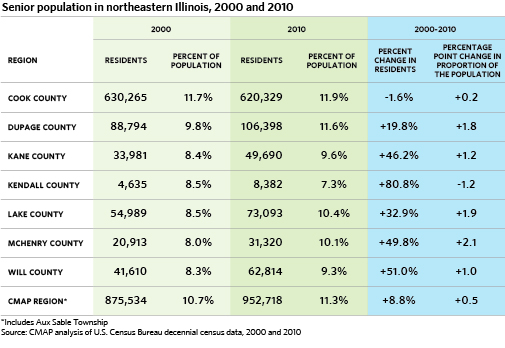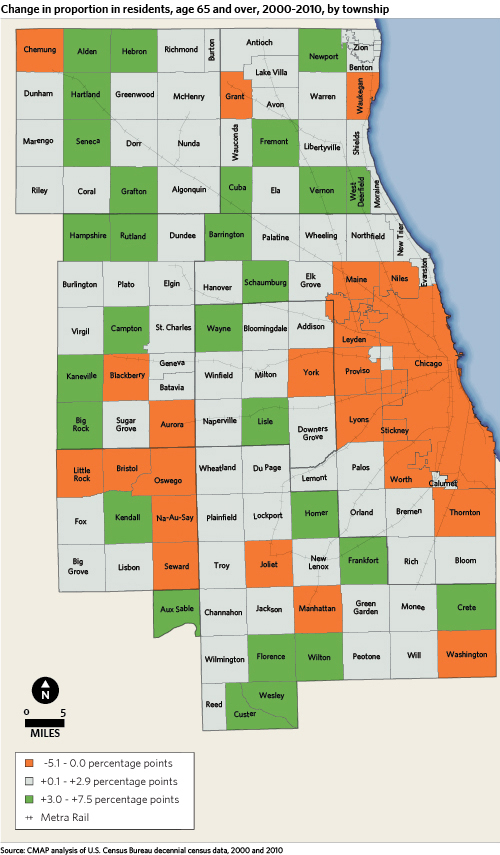As the baby boomer generation ages, the senior population in metropolitan Chicago is expected to continue increasing. According to GO TO 2040, the number of residents between 65 and 84 years of age is projected to double by 2040. Furthermore, the number of residents in the region who are over 85 years old is projected to triple. Much of this growth is projected to occur in parts of the region where residences, services, and commercial areas are currently more spread out and not well-served by public transit, creating difficulties for those who have limited mobility and cannot drive. This phenomenon will have major impacts on future housing, land use, and transportation needs. Sustaining our residents' ability to "age in place" -- to remain in their homes and communities as they age, if they choose -- is a key challenge confronting the region.
On August 4, 2011, the U.S. Census Bureau released additional 2010 decennial census data for Illinois, providing more details than were available with the redistricting data released earlier this year. The release includes age group data, which shows that the senior population is growing faster than the overall regional population, as well as that the median age of northeastern Illinois residents is rising. The following table shows that six out of the seven counties experienced an increase in median age between 2000 and 2010.

McHenry County experienced the highest rate of increase in median age, from 34.2 to 38. Cook, DuPage, Kane, Lake, and Will Counties also experienced increases in median age. These trends were also observed statewide, where the median age increased from 34.7 in 2000 to 36.6 in 2010, an increase of 5.5 percent. Increasing median age may be a sign of the aging baby boomer generation, which is expected to lead to an increasing senior population in both metropolitan Chicago and the rest of the nation.
Senior Population -- Net Change
The release shows that the senior population (residents who are 65 years of age or older) of northeastern Illinois has grown 8.8 percent in the past decade, from 875,534 to 952,718 residents. As a point of comparison, the region's overall population increased by 3.6 percent, from 8.2 million to 8.4 million residents. Geographically, growth in the senior population has largely tracked general population change patterns, with increases in the senior population occurring in the collar counties and decreases in the senior population in Chicago and its inner suburbs. The following table provides an overview of how the senior population has changed in the past decade.

Senior Population -- Changes Relative to Total Population
Due to this growth, seniors have become a greater proportion of the region's population. In 2000, seniors made up 10.7 percent of the total population, and this increased to 11.3 percent of the total population in 2010.
The following map shows a more localized analysis (by township) of the change in the proportion of the senior population in the past decade. (Select this link to see a larger pop-up version.)

While most inner ring suburbs (as well as several communities in outer parts of the region) experienced a decrease in the proportion of seniors of 1 to 4 percentage points, most areas of the region experienced an increase in the proportion of seniors. Twenty-seven townships (shown in green on the map above) experienced growth in seniors as a proportion of the population ranging between 3 and 7.5 percentage points. In total, the senior population of these townships grew by 68.5 percent. For 70 townships (shown in grey), these increases were more modest, with the proportion of seniors increasing between one-tenth of a percentage point and three percentage points. In total, these townships experienced a 25.1 percent increase in residents aged 65 and over.